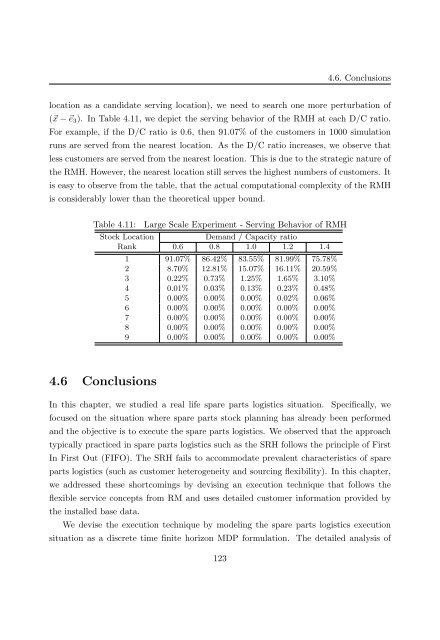Customer Information Driven After Sales Service ... - RePub
Customer Information Driven After Sales Service ... - RePub
Customer Information Driven After Sales Service ... - RePub
Create successful ePaper yourself
Turn your PDF publications into a flip-book with our unique Google optimized e-Paper software.
4.6. Conclusions<br />
location as a candidate serving location), we need to search one more perturbation of<br />
(�x − �e3). In Table 4.11, we depict the serving behavior of the RMH at each D/C ratio.<br />
For example, if the D/C ratio is 0.6, then 91.07% of the customers in 1000 simulation<br />
runs are served from the nearest location. As the D/C ratio increases, we observe that<br />
less customers are served from the nearest location. This is due to the strategic nature of<br />
the RMH. However, the nearest location still serves the highest numbers of customers. It<br />
is easy to observe from the table, that the actual computational complexity of the RMH<br />
is considerably lower than the theoretical upper bound.<br />
Table 4.11: Large Scale Experiment - Serving Behavior of RMH<br />
Stock Location Demand / Capacity ratio<br />
Rank 0.6 0.8 1.0 1.2 1.4<br />
1 91.07% 86.42% 83.55% 81.99% 75.78%<br />
2 8.70% 12.81% 15.07% 16.11% 20.59%<br />
3 0.22% 0.73% 1.25% 1.65% 3.10%<br />
4 0.01% 0.03% 0.13% 0.23% 0.48%<br />
5 0.00% 0.00% 0.00% 0.02% 0.06%<br />
6 0.00% 0.00% 0.00% 0.00% 0.00%<br />
7 0.00% 0.00% 0.00% 0.00% 0.00%<br />
8 0.00% 0.00% 0.00% 0.00% 0.00%<br />
9 0.00% 0.00% 0.00% 0.00% 0.00%<br />
4.6 Conclusions<br />
In this chapter, we studied a real life spare parts logistics situation. Specifically, we<br />
focused on the situation where spare parts stock planning has already been performed<br />
and the objective is to execute the spare parts logistics. We observed that the approach<br />
typically practiced in spare parts logistics such as the SRH follows the principle of First<br />
In First Out (FIFO). The SRH fails to accommodate prevalent characteristics of spare<br />
parts logistics (such as customer heterogeneity and sourcing flexibility). In this chapter,<br />
we addressed these shortcomings by devising an execution technique that follows the<br />
flexible service concepts from RM and uses detailed customer information provided by<br />
the installed base data.<br />
We devise the execution technique by modeling the spare parts logistics execution<br />
situation as a discrete time finite horizon MDP formulation. The detailed analysis of<br />
123

















